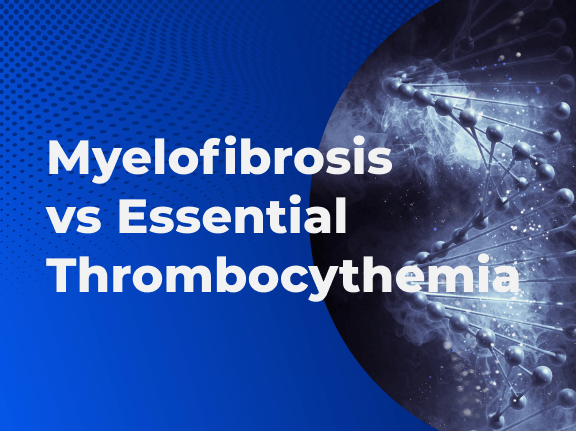Myelofibrosis vs. Essential Thrombocythemia
Myelofibrosis and essential thrombocythemia are both myeloproliferative neoplasms (MPN). All MPNs are types of blood cancer that begin with an abnormal mutation (change) in a stem cell in the bone marrow. Because the bone marrow produces blood cells in an uncontrolled manner, the World Health Organization (WHO) defines MPNs as cancer. All MPNs often develop and progress slowly. They remained stable for a while and mostly did not show any symptoms.
Myeloproliferative disorders differ in the type of blood cells affected, the number of blood cells in the bloodstream, and the symptoms. Most common MPNs are chronic myeloid leukemia (CML), polycythemia vera (PV), essential thrombocythemia (ET), and primary myelofibrosis (PM).
What Is Myelofibrosis?
Myelofibrosis is a rare type of blood cancer in which the bone marrow is replaced by fibrous scar tissue, which is also considered chronic leukemia. When a change (mutation) occurs in the DNA of a single cell, the defective cells are transferred to new cells. The bone marrow begins to lose its ability to produce normal blood cells. Abnormal blood-forming cells can also grow outside the bone marrow in the liver, lungs, lymph nodes, and other organs.
About 50 percent of myelofibrosis patients have a mutation in the JAK2 gene, 5-10 percent have a mutation in myeloproliferative leukemia (MPL) gene, and 35 percent have a mutation called Calreticulin (CALR). Myelofibrosis can occur on its own or in conjunction with other diseases.
What Is Essential Thrombocythemia (ET)?
It is a chronic blood disease that causes the formation of large numbers of blood cells called platelets and has no cure. It usually develops very slowly. It can affect people of all ages. In essential thrombocythemia, stem cells produce too many platelets. Extra platelets can form blood clots. Platelets can also collect in the spleen, which enlarges it. ET rarely progresses to acute myeloid leukemia (AML). Fewer than 5 (5 percent) of 100 people with ET develop AML. On average, individuals with ET have a normal life expectancy if properly monitored and treated. It is unclear what causes ET. About 90 percent of people with ET have a gene mutation that contributes to the disease.
What Is the Difference Between Essential Thrombocythemia and Myelofibrosis?
Bone marrow examination is often necessary to make an accurate morphological diagnosis of ET and to differentiate it from other myeloid neoplasms, particularly prefibrotic PMF; Megakaryocytes in ET are large and mature looking and form loose clumps, while those in prefibrotic PMF show abnormal maturation with hyperchromatic and irregularly folded nuclei and form tight clusters.
ET is traditionally defined by the absence of thrombocytosis and associated bone marrow (BM) fibrosis. In contrast, PMF is defined by BM reticulin (is a type of fiber in connective tissue) or megakaryocyte hyperplasia (is a characteristic feature of malignant or clonal disorders), and dysplasia (is a broad term that refers to the abnormal development of cells within tissues or organs) as well as collagen fibrosis and extramedullary hematopoiesis (refers to hematopoiesis occurring outside of the medulla of the bone (bone marrow). It can be physiologic or pathologic).
Does Essential Thrombocythemia Cause Myelofibrosis?
Essential thrombocythemia is the result of the overproduction of platelets. Very rarely, bone marrow scarring leading to myelofibrosis may occur in patients with ET as the disease progresses. Studies conducted so far have shown that 1-2 percent of patients with ET have their disease turn into PM.
How Often Does ET Progress to Myelofibrosis?
Patients with essential thrombocythemia can lead a normal life with an unaffected life expectancy. A study published in the Blood Cancer Journal reported progression to overt MF in ET compared to previous literature. The cumulative risk at ten years ranges from 0.8 percent to 4.5 percent.
To learn more about Myelofibrosis, read our ultimate guide: Myelofibrosis Ultimate Guide
Sources:













1 Comment
As a patient who has transitioned from a diagnosis of Essential Thrombocythemia to Prefibrotic Myelofibrosis, I am pleased to notify you that I have found this article very informative.